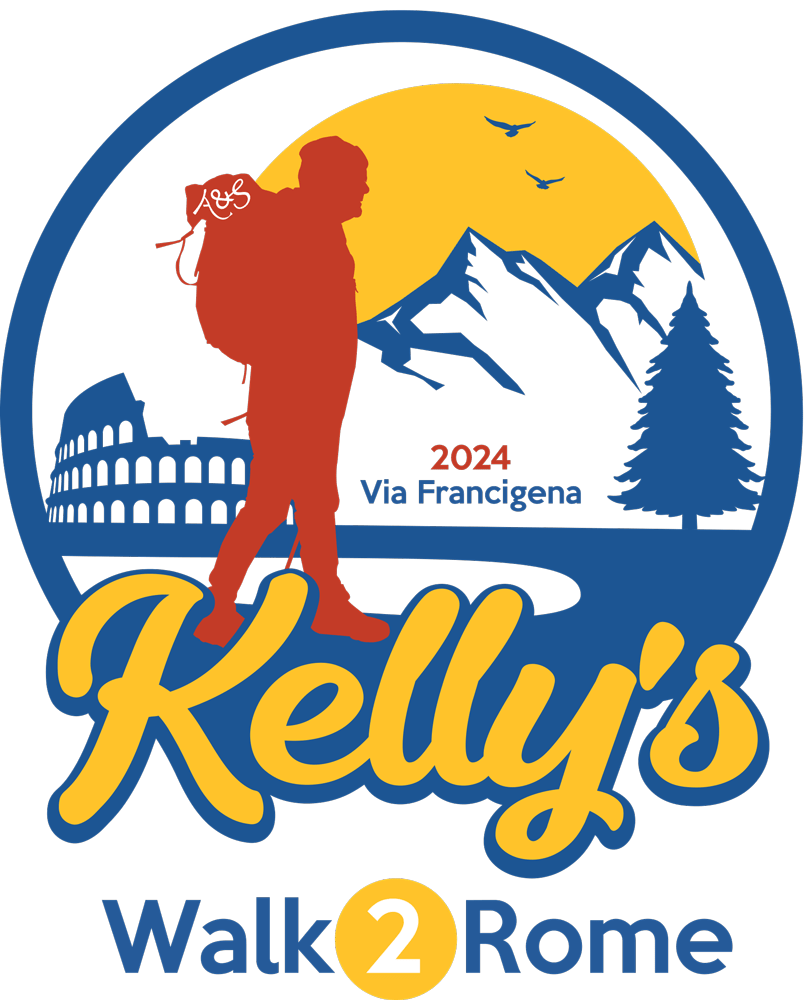The Via Francigena – Sections
SECTION 1 KENT, ENGLAND
While much of Kent is within commuting distance of London, the county has a rural character and is proud of it’s nickname, The ‘Garden of England’.
Rolling hills over a chalk substratum are the primary features and these downs are crossed by the gently hilly North Downs National Trail.
The VF in Kent follows exactly the path of the North Downs way and the trail markers from Canterbury to dover are dual signed for both the VF and the North Downs Way.
SECTION 2 HAUTS-DE-FRANCE REGION
The route crosses 3 departments in this gently hilly agricultural region in the far north of France.
Coastal Pas-de-Calais is known for its cool weather and the Flemish-Belgian cultural influences. Hills spread out into wide fields in the Somme department near Perone, with long canals dug for 18th & 19th century shipping.
Steep rock hills dot the landscape of the forested Aisne department most notably at Laon. The entire region has seen many historic battles with WW1 cemeteries keeping solemn watch over countless fallen soldiers.
SECTION 3 GRAND-EST-REGION, FRANCE
The VF crosses the departments of Marne, Aube and Haute-Marne in this north east region of France where wine is king.
Vast hillside vineyards where the sails and climate have made the regions premier sparkling wine – champagne.
Forests begin to predominate as the route gently climbs up the Marne valley
SECTION 4 BOURGOGNE – FRANCHE. -COMTE
The terrain begins to change after Langres in the Haut stone and Doubs departments of the Bourgogne-Franche-Comte region.
Pastures are interspersed among larger forests.
In the Loue valley where granite bluffs framed by forests stand sentinel above the green valley floor.
The rolling farmlands of France are behind, to be replaced by the ridges and valleys of the Jura mountains.
The Gateway to Switzerland
SECTION 5 SWITZERLAND -VAUD
The canton of Vaud is in Normandy, the French speaking region of Switzerland. Here the slopes of the Jura mountains descend to the Swiss plateau, entered at Lac leman (Lake Geneva)
The lofty snow covered peaks of the French and Swiss Alps dominate views across the glimmering lake.
This is regarded as one of Switzerlands most beautiful regions.
SECTION 5 (CONTD) THE VAUD AND THE VALAIS
This mountainous route leads thru the french speaking Vaud & Valais cantons along the Rhone river from Lac Leman (Lake Geneva) up its alpine tributaries in the Dranse and Dranse d’Entremont valleys reaching the Via Francigena’a highest point at the dramatic 2478m Col du Grand-Saint-Bernard.
SECTION 6 AOSTA VALLEY
The route from the Great Saint Bernard Pass is at first steep and then more gradual as it descends along the Dara Ballet Valley among the forested peaks of the Italian Alps.
SECTION 7 PIEMONTE
The valley begins to widen as the terrain turns to rolling hills, all set against a backdrop of the Alps which gradually fade on the horizon earning the region the name
Piemonte – “Foot of the mountains”
Vine yards predominate on the low slopes until the terrain flattens to vast irrigated fields of rice.
SECTION 8 LOMBARDIA
Although modern and cosmopolitan Milan is capital of Lombardia, the route feels centuries removed from the modern world as it travels through grain fields of the flat and fertile PO valley.
Remnants of the traditional economy that predominated here for centuries are still visible in the walled farming villages and contrast with the youthful energy of the university town of Pavia.
SECTION 9 EMILIA -ROMAGNA
After leaving vibrant Piacenenza, the route spends a final 2 days in the flatlands of the PO valley before crossing the Taro river and climbing the densely forested Ligurian Apennine range to 1215M Monte Valeria above Cisa Pass.
The lowland farming region produces the renowned Parmigiano- Reggiano (or Parmesan) cheese while the uplands are known for truffle and porcini mushrooms found along quiet mountain trails and meadows.
SECTION 10 LIGURIA & TUSCANY
The route heads down the green slopes of the Magra river drainage, finding the narrow Ligurian coastal plain at Sarzana.
Keeping to the foothills rather than the coastline the route then transits the Apuan Alps of the Apennine range toward lovely Lucia, one of Tuscany’s best preserved and most beloved medieval cities.
SECTION 10 (CONTD) TUSCANY
With rolling hills of grain dotted with stone villas guarded by rows of sentinel-lite cypress trees Tuscany is a multi coloured visual feast.
The terrain rises from near se level at Lucca to a high point of the border with Lazio and undulates among river valleys and ridges populated by historic towns with artistic and architectural treasures.
SECTION 11 LAZIO
Sparking blue Caldera lakes are set atop ridges of Volcanic tufa stone covered by forests of Oak and chestnut in Lazio.
The valleys are home to crops of hazelnut or grapes while the towns are simple and subdued as though reserving themselves to give greater glory to their Capital, The Eternal city.
Graced with an antique grandeur Rome exudes beauty, history and faith.








